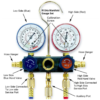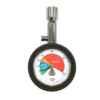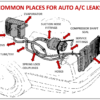Understanding EPA-Mandated Self-Sealing Refrigerant Cans and Dispensing Equipment
Moving forward at FJC we will be shipping only self-sealing cans which, due to an EPA-mandated design change, necessitate the use of new dispensing
equipment. Please refer to the following to determine the appropriate part number for use with the new can style:’

As mandated by Section 608 of the EPA Clean Air Act, all FJC R-134arefrigerant products produced in 2018 are equipped with self-sealing valves which remain closed when the recharge hose is removed. Most refrigerant products produced prior to 2018 were equipped with a puncture-style valve.
Below are comparative pictures highlighting the major differences between the “puncture” and “self-sealing” style cans. The aerial view of the cans shows the major differences in cap appearance. In the traditional “puncture” style, a thin metallic membrane in the center of the threads is permanently pierced by the dispensing tap, opening refrigerant flow from the can.

The self-sealing can on the right replaces the foil with an internal Schrader-like valve which regulates flow dependent on the pressure applied by the dispensing tap. A unique benefit of the “self-sealing” can is that the dispensing tap can be completely removed from the can without venting the remaining
refrigerant. When the tap is removed, pressure is released from the internal valve allowing the mechanism to completely seal the top of the can. As a result, each can is preserved for multiple uses: benefiting both technicians and the
environment.
The significant differences in the functionality of caps creates the necessity for specifically designed dispensing equipment compatible with “self-sealing” cans.
The differences in can tap technology are apparent on the side view. The “puncture” style on the left has a hollow thread body, while the valve mechanism on the “self-sealing” cap to the right rests in the center core of the threading and extends down the dip tubing. The spring-loaded valve travels vertically through the center body of the cap, increasing flow the further it is depressed into the can.
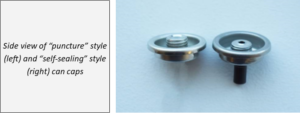
The internal mechanisms of the “self-sealing” can tap function entirely differently from the legacy part, and the two pieces should only be used on the correct can.
One of the important design specifications of the “self-sealing” tap is the dispensing actuator, which is designed to meet specific tolerances of depth and diameter prescribed by the internal can cap valve (as seen in the picture above). Notable differences also include distinct internal mechanisms for starting and controlling flow as well as an integrated backflow preventer to maintain safe operating pressure in the can and dispensing equipment.
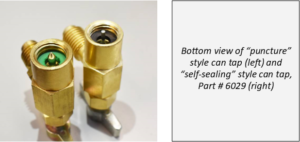
Let us know if you need any additional information and we will be happy to help.
LMK 2019


